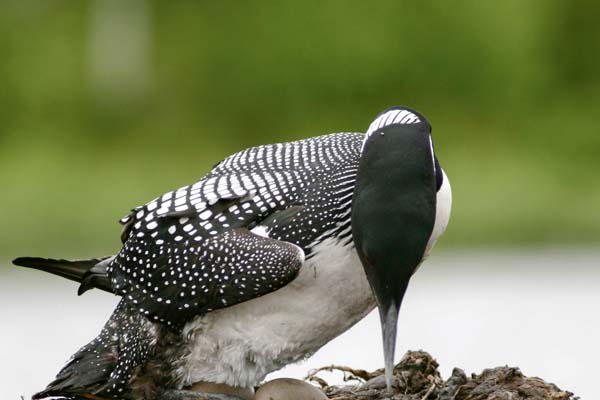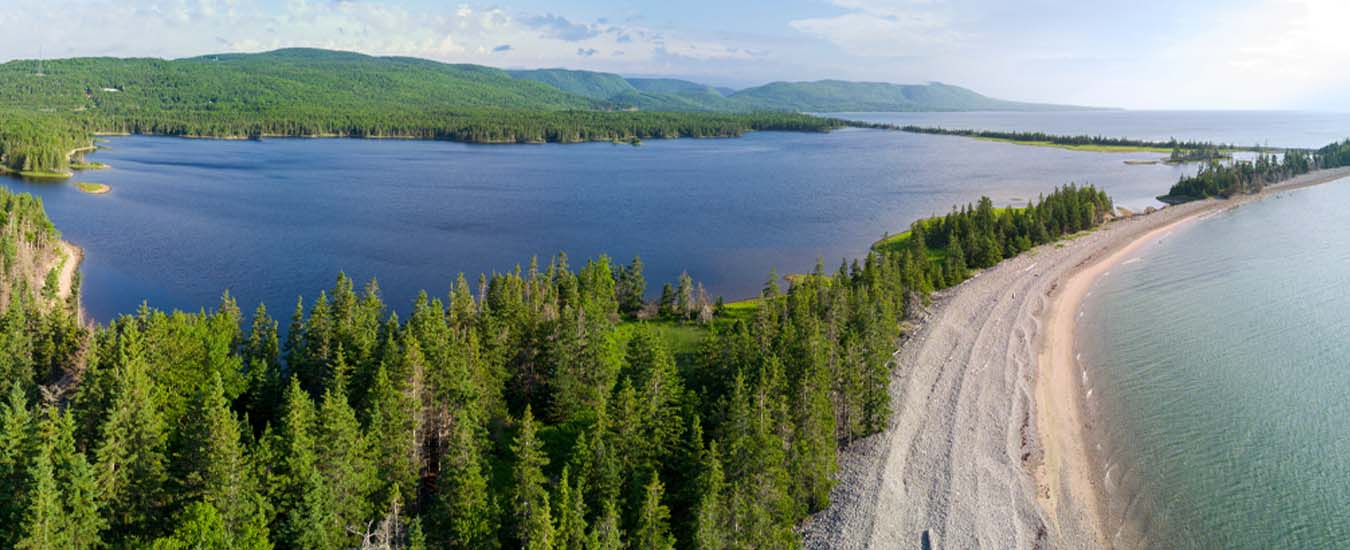The magic of watching a family of loons on a Cape Breton Lake
A loon swims through the downpour not far from where I sit on the shore of MacDonald’s Big Pond in Cape Breton. Pummelling raindrops roll off her waterproof feathers as she heads toward a nearby islet. She rolls lazily forward into a dive and disappears beneath the rain spattered surface. A moment later she’s up with a wriggling minnow. Her chicks, fist-sized bundles of grey, downy feathers just a few weeks old, emerge from behind the islet, swimming toward her through the pelting rain. One of them races forward, bill open to signal hunger. The adult tenderly gives it the fish. The other chick, a little smaller, will have to wait for the next delivery. From across the lake the adult male calls- owwwww-ooooo-ahhhhhh- as if to say “I’m over here, everything is fine.” Summer is going perfectly to plan for this loon family in this beautiful place on Cape Breton Island...
MacDonald’s Big Pond is an ideal habitat for loons to raise a family. The shallow, one square kilometre body of fresh water boasts abundant small fish. It’s also separated from the ocean only by a long, narrow barrier beach, allowing one of the adults—the other stays with the chicks—to occasionally pop over into saltwater to catch fish. To the west are the majestic highlands of the French River Wilderness Area, of which the pond and its surrounding forest are a protected adjunct.
I’ve been visiting this coastal lake in northern Cape Breton since early June, when I first discovered a common loon sitting stoically on her nest, in full sun, at the peak of a searing heatwave. Despite the heat, I was most concerned about the nest’s very close proximity to a trail along the lakeshore. Would people passing so near cause the loons to abandon the nest before the eggs hatched?

An incubating parent turns her eggs.
A week after discovering the nest I returned in cooler weather, worried that it might have been abandoned. To my relief, nearby I saw an adult swimming with two elfin heads poking from beneath its wings. The nesting was a success. Two new miracles of nature had come into the world.
Over the next several days the young stuck very close to their parents. So much so, that the adults had practically become full time water taxis! Sometimes, both chicks rode on one bird; at others, one rode on each adult. The family stayed in the general area of the nest at the southern side of the lake. To protect them from predators such as bald eagles and gulls, one parent remained with the chicks at all times, while the other dived for minnows. The hungry young were fed many times an hour.
The chicks had grown significantly by the time of the heavy downpour a few weeks later in mid-July. Now a month or more old, they were doing short dives on their own. Occasionally, they still rode on the adults’ backs, but only one at a time now. During feeding, instead of being passed directly to the young, fish were often dropped in front of the chicks so they could practice catching them. Bigger now, and able to make brief evasive dives from predators, chicks could be left unattended on the surface for short periods while both parents foraged for fish.
By August I had trouble finding the loon family. They were no longer hanging out where I’d always seen them. I eventually spotted them on the opposite side of the pond, a kilometre away.
The nine-week-old chicks had a growth spurt and were looking more like adults. The soft, downy plumage of a chick was replaced by the stronger feathers of juveniles and the sleeker profile of an adult. The iconic loon checkerboard pattern—though still less defined on the young—began to appear in greys and browns. Strong feathers would be soon needed for flight as the juvenile birds got closer to fledging. They’d also begun to vocalize, softly churring when adults approached. More self-sufficient now, they occasionally caught their own fish.
In a few short weeks the adults would depart MacDonald’s Big Pond for the Atlantic, forever leaving their newly independent young to fend for themselves on their natal pond until they, too, left for the ocean.
There were no loons on MacDonald’s Big Pond in late September when I visited. I’d enjoyed following them for the summer and was a little sad to see them go. But on the saltwater of St. Ann’s Bay, in a cove that lay just over the barrier beach from the pond, I found two adult-sized juvenile loons swimming along and diving for food. They were on their own now!
